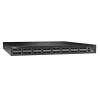Dell S6000 Dell Networking Installation Guide - Page 31
Installing QSFP+ Optics, Remove QSFP+ Optics, Split QSFP+ Ports to SFP+ Ports
 |
View all Dell S6000 manuals
Add to My Manuals
Save this manual to your list of manuals |
Page 31 highlights
Installing QSFP+ Optics The S6000 has 32 40Gbps QSFP+ optical ports. WARNING: ESD damage can occur if components are mishandled. Always wear an ESD-preventive wrist or heel ground strap when handling the S6000 and its components. WARNING: When working with optical fibers, follow all warning labels and always wear eye protection. Never look directly into the end of a terminated or unterminated fiber or connector, which may cause eye damage. To install QSFP+ optics into an open port, follow these steps: 1 Position the optic so it is in the correct position. The optic has a key that prevents it from being inserted incorrectly. 2 Insert the optic into the port until it gently snaps into place. LR4 optics can be installed only on top row front end ports 4, 12, 20, 28, 36, 44, 52, 60, 68, 76, 84, 92, 100, 108, 116, and 124. NOTE: Both rows of QSFP+ ports require that you insert the 40G optics with the tabs facing up. Remove QSFP+ Optics Remove an optic by pushing the tab on the optic and sliding the optic from the port. When removing optics with direct attach cables (DACs) from the port, pull the release tab firmly and steadily. Prior to pulling the release tab, you may need to gently push the optic into the port to ensure it is seated properly. Do not jerk or tug repeatedly on the tab. Split QSFP+ Ports to SFP+ Ports The S6000 supports splitting a single 40G QSFP+ port into four 10G SFP+ ports using one of the supported breakout cables. This splitting is not allowed on ports 4, 12, 20, 28, 100, 108, 116, and 124. When you use the fanout feature, the 40G QSFP+ port is deleted and four10G SFP+ ports are created. For the system to recognize the port type change, enter the stack-unit portmode command. For example: stack-unit stack-unit port number portmode quad • stack-unit: Enter the stack member unit identifier of the stack member to reset. The range is from 0 to 5. • number: Enter the port number of the 40G port to be split. The range is from 0 to 124. Important Points to Know: • The unit number with the split ports must be the default (stack-unit 0). You can verify this using the show system brief command. • The quad port must be in a default configuration before you can split it into four 10G ports. The 40G port is lost in the configuration when you split the port, so be sure that the port is also removed from other L2/L3 feature configurations. Install the S6000 | 31















